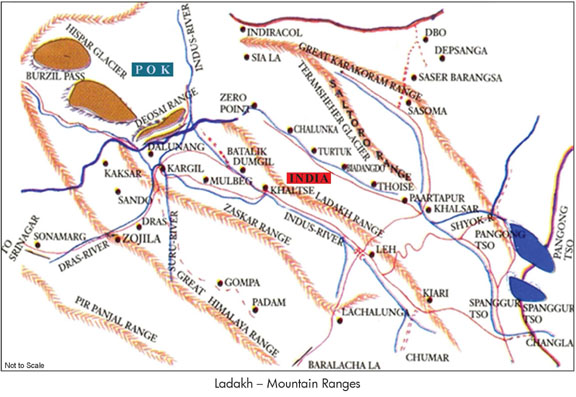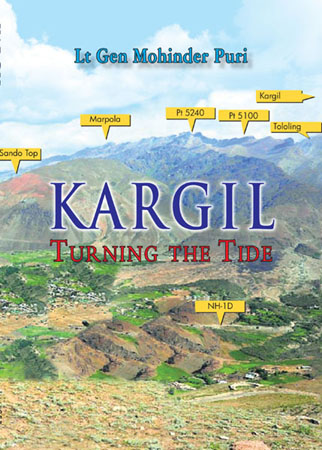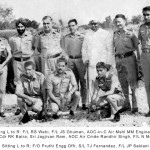It was indeed my professional privilege to command the ‘Forever in Operations’ 8 Mountain Division during Operation Vijay, our response to Pakistan’s Operation Badr. I had been in command of the Division in the Kashmir Valley for over a year, where it had been deployed since 1989 for Operation Rakshak to fight militancy, when Pakistan’s misadventure in Kargil started unfolding in May 1999. The task was daunting as it came with the challenge of reorienting the Division operationally from counter-insurgency to conventional operations virtually in no time and to deliver success almost instantly in view of the tremendous pressure of public opinion at home to ‘taste victory’, and a strategic imperative to complete the operations well before the onset of winter. Since the operations had to be conducted at extreme high altitudes averaging 15,000 ft, troops had to undergo three stages of acclimatisation lasting 10 days or more to be able to give off their best. I salute the stoic bravery, stout-heartedness, raw courage and the sheer ‘will to win’ of all ranks of the Division for yet again meeting all the challenges squarely and coming out victorious, adding another glorious chapter to the saga of valour and sacrifice not only of the Division but of the whole Indian Army.
Pakistan as a nation, with its army in particular, is obsessed with Jammu and Kashmir, and more so the Kashmir Valley, and this continues to bedevil relations between the two neighbours. With its weak polity and a domineering military, democracy, unfortunately could not take deep roots in Pakistan, which has witnessed several military dictatorships since its independence. The disdain with which the Pakistan military looks upon its political class and the extra-constitutional authority that it wields with the support of the Inter Services Intelligence in the country’s policy and decision-making is an open secret. Kashmir for Pakistan army is not only the unfinished agenda of the partition but is also its raison d’etre, which it considers of paramount importance to retain its relevance as the primary power centre of the country. Having repeatedly suffered humiliation in its attempts to wrest control of the Kashmir Valley militarily, in conventional conflicts post-independence, the Pakistan army under the late General Zia-ul-Haq seemingly decided to opt for covert, unconventional approaches in the low-intensity conflict domain and conceived the diabolical ‘Operation Topac’ to inflict a ‘thousand cuts’ on its adversary, India. After its support to the terrorism-based secessionist movement in the Punjab in the early eighties, Pakistan was successful in its design of stoking the fires of a massive insurrection in the Kashmir Valley in early nineties. A decade down the line in 1999, Operation Badr, as the Pakistani operation in Kargil was code-named, marked the high point of ‘Operation Topac’ when Pakistan found its well-conceived plan for annexation of the Valley, this time round through a people’s movement, floundering once again.
In early April 1999, the Corps war game was to be conducted for which I had been nominated as the commander of the enemy forces. I had completed my reconnaissance of the Ladakh sector and had interacted at length with the local commanders. In the Kargil sector my plan in essence was to launch a pre-emptive attack at selected places with the aim of securing tactical features which would improve the defensive posture and draw adequate reserves and a reaction from the Valley. Ironically, the plan envisaged capturing areas like Tiger Hill and Tololing, which a month later were in possession of the Pakistani forces and had become household names in India. War games are meant to validate our defensive or offensive plans and should take into consideration enemy actions which appear tactically feasible. Unfortunately, in the war game not much attention was given to this manoeuvre, with the ‘control staff’ opining that the operation was not tactically sustainable or viable. I was quite surprised that no serious thought was given to the “enemy” plan and the control staff disposed it off for its unviability, an action we were to regret a month later.
Even though the war in Kargil was a ‘local war’ being confined to the Kargil theatre, it had tremendous strategic significance. For one, coming exactly a year after the two nations acquired overt nuclear power status, it validated the strategic viewpoint of there being space for conventional conflict between nuclear belligerents. While there would have been sound reasons for the political decision to limit the geographical extent of the conflict even to the extent of not allowing crossing of the Line of Control, it did put the troops on ground to great tactical disadvantage resulting in avoidable loss of lives, and perhaps missing an opportunity to ‘call the Pakistani nuclear bluff.’ The Kargil war also came shortly after a visit by our then Prime Minister to Pakistan, which once again displayed disconnect between the Pakistani military and its polity on Kashmir and stranglehold of the military on the Kashmir policy. The war was also yet another instance of Pakistan military’s miscalculation of Indian political will and military response which paved the way for a Pakistani withdrawal from occupied areas and an early cessation of hostilities. Another significant aspect of the conflict was the role played by the electronic media in bringing the war into the ‘drawing rooms’, which, of course was not without its adverse impact on security of ongoing operations, as also the increased pressure of public opinion on the commanders and troops on the battlefield.
Notwithstanding the end result, the war exposed serious chinks in our national security mechanisms at all levels. At the politico-diplomatic level, the euphoria and bonhomie of a ‘successful’ Prime Ministerial visit to Pakistan, notwithstanding the impertinence of then Pakistan’s Army Chief, General Pervez Musharraf, in failing to pay due compliments to our Prime Minister, seems to have lulled the establishment into ignoring the realities of Pakistan’s Kashmir policy and control of its military over it. At the other end of the spectrum, even as the troops on the ground faltered in monitoring the situation, the intelligence agencies at the national level also failed to pick up Pakistani build-up for the operation allowing them to infiltrate as much as 10-12 kms across the Line of Control with total surprise and impunity. At the field level, the troops found themselves less than adequately equipped and armed to join battle at such short notice. Regrettably not much seems to have changed a decade and a half down the line. Some key recommendations of the Kargil Review Committee Report are yet to be implemented. While we have since evolved very elaborate Defence Procurement structures, policies and procedures, these have in effect turned out to be ‘mill stones’ around the armed forces’ necks causing degradation rather than upgradation of our levels of operational preparedness. Critical deficiencies continue to persist and reports appearing in the media only point to a tardy, rule-bound, play-safe bureaucratic approach being adopted to address the same and not the urgency cutting across rules and procedures, which such operational voids merit. I do hope with the Bhartiya Janta Party government the armed forces see better days in meeting their aspirations for modernisation.
Kargil war may perhaps be one of the most reported upon, written about wars in recent times in the subcontinent. For me, who was so intimately involved in the operations of 8 Mountain Division, besides my preoccupations and constraints while in service, it perhaps needed time to shed sentiment and emotion to pen down a largely objective narrative of the operations of my Division. Kargil: Turning the Tide is essentially a military history of the operations of 8 Mountain Division with a brief overview of 3 Infantry Division operations to complete the picture. Nevertheless, I expect it to be still of as much interest to a civilian reader as to military readers across the spectrum. Three Param Vir Chakras, eight Mahavir Chakras, 42 Vir Chakras, and numerous other gallantry awards, coupled with casualties, 268 killed and 818 wounded, speak volumes for the bravery and courage of its men especially the junior leaders. In a work of this nature it has not been possible for me to narrate in full detail the heroic deeds of each and every one of them, for which I seek their understanding and that of their kith and kin. As a mark of respect to them I humbly dedicate this book to All Ranks of 8 Mountain Division.






